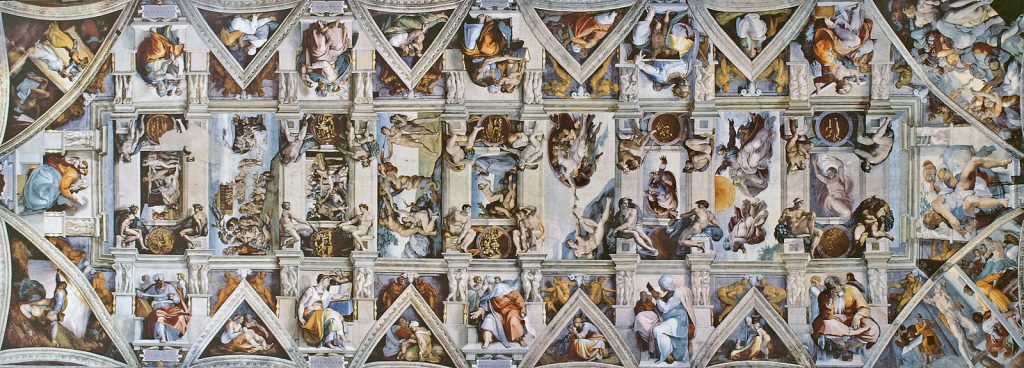From 1508 to 1512, it took Michelangelo five long, torturous years to complete the rigorous task of painting the ceiling of the Sistine Chapel. Spanning more than 10,000 square feet, the iconic piece of high Renaissance art is familiar to many people. Nevertheless, despite Michelangelo’s distinct ability to imply powerful expression and emotion into his art, most people fail to interpret the full story behind the talented artist’s five-year journey. Many may not realize that the beautiful, intricate depictions attributed to Michelangelo were actually painted by an unskilled artist. Likewise, one would not even dare think that the hand behind the brush had minimal interest in painting such marvelous masterpieces.
Michelangelo was by no means recognized as a skilled painter in his time. His fame, rather, came from the sculptures he chiseled in Rome and in Florence in his earlier years. His first sculpture in Rome was Bacchus (1496-1497), which he sculpted for a French ambassador’s barber. The French ambassador then commissioned Angelo to sculpt the Pietà (1498-1499). It was to be Michelangelo’s first contribution to the Catholic Church. The sculpture depicted the Virgin Mary holding the dead body of Jesus Christ. It was widely admired for the pure and simple expression of Mary and the holy serenity of Jesus even in the stillness of death. A few projects later, Angelo worked in Florence, sculpting the massive statue of the biblical hero David. The sculpture David (1501-1504) left Florentine citizens and artists, such as Leonardo Da Vinci, in awe. Eventually, he was assigned to work with Da Vinci painting war cartoons on the walls of the great municipal hall of Florence, known as the Palazzo Vecchio. After treating Da Vinci with severe discourtesy, he was summoned to Rome, by Pope Julius II for a new commission in 1505.1

Upon arriving in Rome, Michelangelo was employed to work on a mausoleum, or sepulcher, for the pope. Julius desired a tomb spanning eight hundred square feet, three stories high, and adorned with twenty six statues. He was willing to pay Michelangelo more than two hundred thousand crowns to complete the grand project. However, the pope’s desires were too extravagant and the expense was absurdly high, so the St. Peter’s basilica, where he desired his tomb to lay, would not allow it. Julius II and Angelo had developed an intimate friendship at this point, as they shared a proud, willful, and honest character. It was tough love between them; they always found a way to reconcile after constant quarreling and the loss of each others’ trust. Suddenly, however, after being denied his mausoleum, the pope’s demeanor changed and he excluded Angelo from the Vatican.2 Donato Bramante, a papal Italian architect, instigated this trouble by warning the pope of the evil omen he invited by constructing his death monument during his lifetime. Jealous of Angelo’s illustrious talent, Bramante encouraged Julius to hire Michelangelo to paint the ceiling of the Sistine Chapel instead, hoping that he would fail miserably. Meanwhile, triggered by his banishment, Michelangelo decided to abandon the pope and return to Florence.3
Three years later, in 1508, after multiple attempts by the pope to forcibly return the skilled artists to Rome, Michelangelo finally met with him. The pope hired him to paint frescoes of the twelve Apostles on the Sistine Chapel ceiling, but Angelo hesitated, knowing that he had inadequate practice with fresco-painting. Nonetheless, Julius repeatedly urged Angelo to accept the job, until finally, Angelo reluctantly gave consent under one condition.4 Michelangelo asked that something more tasteful be painted on the ceiling; he wanted to be allowed to “do as he pleases.” He suggested nine scenes from the book of Genesis, beginning with the creation of the world and ending with Noah and the flood.5

The pope granted his request, and Michelangelo started right away. Bramante was given the task of constructing the scaffolding, but his approach was inefficient and it made holes in the ceiling. This angered Angelo so much that he got the pope’s permission to banish Bramante, and he make the scaffold himself. After making a better scaffold structure, Michelangelo still doubted his abilities for the task, so he summoned his childhood friend, Francesco Granacci, to aid him in preparing designs for the frescoes. Angelo got the hang of it quickly, and soon enough, Granacci and two other assistants were painting over the master’s chalk outlines. Michelangelo’s arrogance engulfed him though, and he regretted inviting his three assistants, who could not express the art in harmony with his detailed ideas. He sent his friends back to Florence and set forth on the project alone, where he spent most of his days alone in the sombre space between the platform and the ceiling. Michelangelo became frustrated; he ached daily from having his head thrown back, spine arched downward, and face covered in paint. Matters only got worse as the winter neared.6
From May until the first winter, nearly one third of the ceiling was complete, but it was all ruined by mold that developed under the perfect conditions of the cold weather and moisture in the Roman lime Michelangelo used to make the plaster. Devastated, Angelo gave up, and shouted to the pope, “I told you I was no fresco-painter; what I have done is ruined.” He took a break from the project for nearly a year, as he waited for favorable weather and for the mold to disappear. It was after this break that Michelangelo’s frescoes underwent an evident change. The paintings became larger and more expressive and emotional. He continued the back-breaking work until it was finally completed in 1512.7
Notably, one well-known fresco that depicts The Creating of Adam, clearly demonstrates Michelangelo’s shift in form and style. The large twisted bodies are very expressive, and the movements portray a strong emotion that can be easily perceived, even from the chapel ground! This style completely contrasts Angelo’s first few frescoes, which were small and complicated. In particular, the scene of The Great Flood is full of action when viewed up close. The fresco contains four stories alone, but they cannot be seen well from the ground. Michelangelo was aware of this issue, but he decided not to feed his frustration and continued painting the ceiling, with the new approach.

Completing the job was not easy for Michelangelo, he had to fight through the strong hatred he developed while painfully painting the frescoes. Some scholars believe that Michelangelo suffered from deconditioning syndrome, which is a state of physical and emotional lethargy as a result of a lack of exercise or movement for long periods of time.8 However, this is due to a common misconception that he worked laying down on the scaffolds, close to the ceiling. In fact, Michelangelo spent hours upon hours with his head bent back, his spine curling in on itself, and his feet aching because he painted standing upright on his designed scaffold. He regretted ever accepting the task; he even wrote a poem in 1509 describing how much he loathed the whole situation:
From the year 1513, when the chapel finally reopened to the public, until the present day, Michelangelo’s arduous accomplishment lives on as a renowned piece of art. The paintings have acquired a low tone due to withering and reckless care, but they still stand to show that he conquered the task and surpassed those who doubted him. Although it may have costed him physical and mental health, his dedication and skill continue to inspire artists and historians, and astonish all those who view his works.10

- Moses Sweetser, Michael Angelo (Michigan: Houghton, Osgood and company, 1878), 23-35. ↵
- Moses Sweetser, Michael Angelo (Michigan: Houghton, Osgood and company, 1878), 34. ↵
- “Michelangelo’s Painting of the Sistine Chapel Ceiling,” ItalianRenaissance.org, May 9, 2013, http://www.italianrenaisance.org. ↵
- Moses Sweetser, Michael Angelo (Michigan: Houghton, Osgood and company, 1878), 48-49. ↵
- “Michelangelo’s Painting of the Sistine Chapel Ceiling,” ItalianRenaissance.org, May 9, 2013, http://www.italianrenaissance.org ↵
- Moses Sweetser, Michael Angelo (Michigan: Houghton, Osgood and company, 1878), 50. ↵
- Andrew Graham-Dixon, Michelangelo and the Sistine Chapel (New York: Skyhouse Pub, 2009), 1-35. ↵
- Raffaella Bianucci et al., “Michelangelo Buonarroti (1475-1564) had the Deconditioning Syndrome While painting the Sistine Chapel Ceiling,” Medical Hypotheses 113, (April 2018): 13-14. ↵
- Gail Mazur, “Michelangelo: To Giovanni Da Pistoia When the Author Was Painting the Vault of the Sistine Chapel,” Poetry 1, no. 1 (2005): https://www.poetryfoundation.org/poems/57328. ↵
- Moses Sweetser, Michael Angelo (Michigan: Houghton, Osgood and company, 1878), 57-58. ↵



120 comments
Jasmine Rocha
This article was nominated for the best use of images. Every image used in this article compliments what is written down because it shows the amazing work on Michelangelo. Not o the Chapelnly did the article explain the hardships that Michelangelo went through when painting the Sistine Chapel but in the end, it appreciated his works and every single picture shows the hard work and beauty in the art that was final.
Antoinette Johnson
Michelangelo was a great painter and made great sculptures. It is funny to think of him not wanting to paint the ceiling of Sistine Chapel because it is a beautiful painting. It is reasonable for him to feel like it was too much. It took him a long time to paint it, especially with the different conditions (weather and Bramante). Michelangelo no matter whether he felt hatred toward painting or not is still one of the greatest artist.
Damian Jennings
I have never heard of Michael Angelo before but I have definitely heard of the famous Di Vinci and I am very familiar with the pieces he has sculpted, but I what I found interesting was that the two collected came together, they collided their skills and began creating art together. The pictures of the Sistine Chapel were astonishing, it was a great visual to glance at but I am sure the detail is even more definite in person; their work is moving as this article did a great job depicting the origin and collaboration of the two.
Pedro Gonzalez Aboyte
Michelangelo is, without a doubt, regarded as one of the greatest artists of all time. It is truly incredible how he managed to paint the Sistine Chapel because there was an immense amount of pain he was going through while painting. He also had to do it forcefully to a certain degree which made it all that worse of an experience for him. It was a great sacrifice that he took and created a beautiful piece of art. This was a good article and I enjoyed reading until the end.
Daniel Linstead
Doing art throughout this semester learning about Michelangelo in that class. We touched on it briefly in the class but this article was able to clarify and give me more depth about him. Also, congratulations on your nomination for the best use of images. Always nice to see that your hard work through the semester has the potential to receive some recognition.
Honoka Sasahara
I did not know the process that Michelangelo completed the painting on the ceiling before reading this article. I think that his decision to drew the painting alone was right because drawing with other persons might change the mood of the art a lot. The drawing is definitely one of the most important arts that keeps offering inspirations to many people in the world.
Nathan Alba
Ah Michelangelo, I think we all know the name, and to an extent, some of his masterpieces. I have heard very little about his experience on the Sistine Chapel, but not like this. I think this article did well to inform the reader much absolute effort it takes a person to complete such a feat. On top of that I think it really shows the struggles Michelangelo faced being renowned for his sculptures to transitioning to his greatest painting masterpiece.
Matthew Wyatt
Great works of art often require great sacrifice and this story highlights that well. It’s interesting to think of Michelangelo, regarded as one of the greatest artists of all time, struggle so hard to complete what became a labor of dismay. Several sentences in this article are oddly worded and could be streamlined to provide a better reading experience.
Robert Freise
Michael Angelo is one of the most influential artist of his time. The way he captivated his audience with amazing pieces of art amazes me this day. It is truly great that we’ve had such fascinating painters in human history. This article really emphasizes the aspects of Michael Angelo’s life and it goes into great detail of how his talents contributed to his monumental success of how he painted and how he sculpted. Great article!!
Arieana Martinez
I had no idea the pain that Michelangelo endured to finish this wonderful work of art. This commission literally is what brought upon his death, but little did he know the impact he would make on everyone around the world for centuries after his death. I really like how the article gave us background on him first, and showed that he was never really the happiest person and took his anger out on everyone, even renounced artists that were on his same level. He clearly had some issues, but this most likely added to his artistic expression. Amazing article.